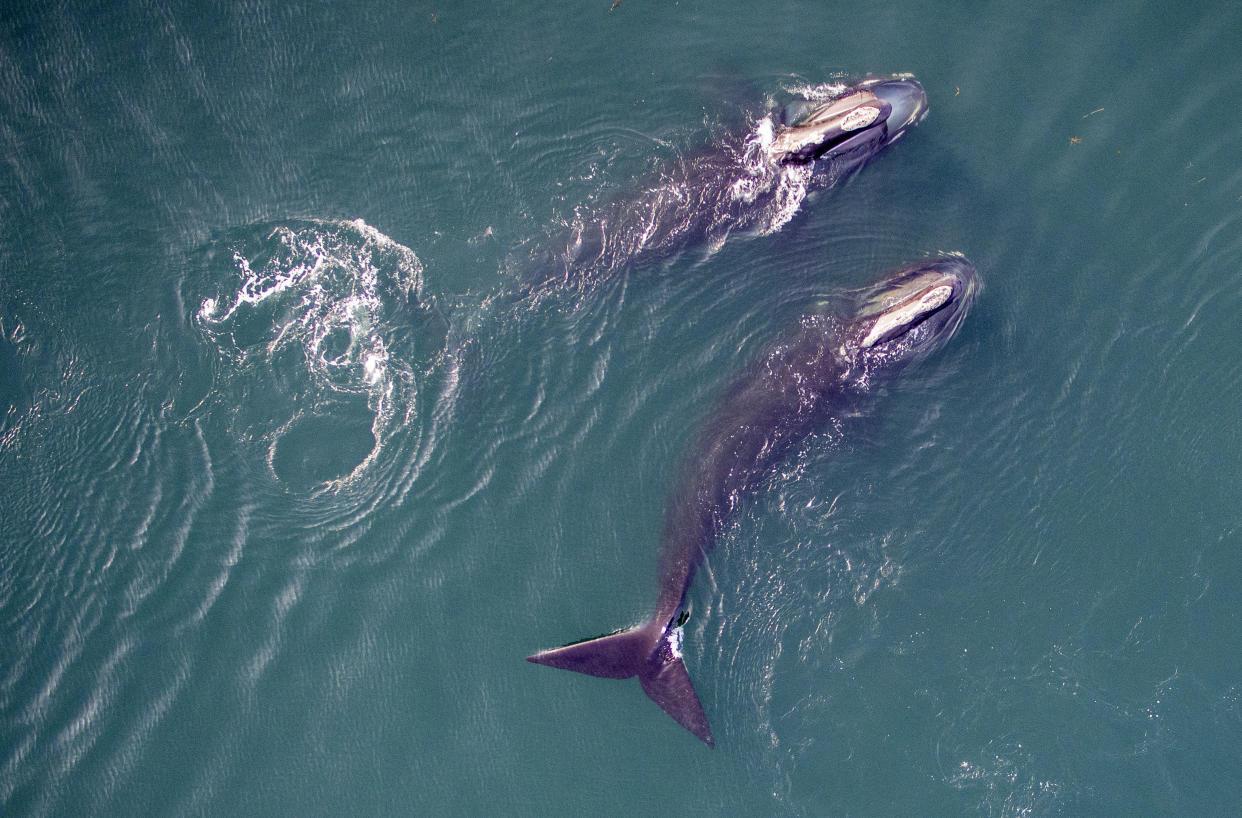We Must Save the North Atlantic Right Whale to Save Ourselves

Aerial view of a pair of skim feeding North Atlantic right whales. Credit - Michael Moore and Carolyn Miller—Courtesy of Woods Hole Oceanographic Institution/ NOAA NMFS permit 21371
I was 23 years old the first time I saw a whale entangled in a large codfish trap. I was researching humpback whales off the coast of Newfoundland in 1979, and the animal’s pain and suffering, along with the apparent extreme agitation of another whale close to it, struck me to my very core.
44 years later, it still hits a nerve: Whales are continuing to suffer and die after becoming struck by vessels and entangled in fishing gear—and doing so at a rate great enough to put the North Atlantic right whale in critical danger of going extinct.
A 2022 report from the North Atlantic Right Whale Consortium finds there are just 340 North Atlantic right whales left and the population continues to spiral downward. These whales live most of their lives in a highly “urbanized” ocean, where fishermen set up to 1 million vertical lines along their migratory routes and foraging areas. Entanglement in these lines is their leading cause of injury and death.
It’s an unfortunate mismatch of risk. The chance of one trap out of a million entangling a whale is small, but the likelihood of a whale becoming entangled while swimming through a million lines is very substantial. Likewise, the risk of any one whale being struck by a vessel is vanishingly small, yet vessel strikes are the second most common cause of injury and death to right whales. If we do not find a way to manage for these risks, we will be responsible for letting an entire species of whale go extinct.
Data shows that over 80% of these whales have been entangled in fishing gear. Many have been entangled multiple times. Of whales that die from entanglement only a minority are documented, as they often sink to the bottom of the ocean undetected. The average duration of a lethal right whale entanglement is about six months.
If a mammal the size of a whale were entangled and slowly dying in the streets of Boston for six months, it would be utterly unacceptable to society. This is exactly what’s happening at sea. The only difference is that we don’t see them as they struggle and pass away. Out of sight cannot mean out of mind.
Read More: What Humans Owe Animals
Whale scientists have been warning for years that additional measures are needed to reduce these entanglements. To win the race to save the North Atlantic right whale, we must take the long view and show restraint and respect for our ocean resources. The broader role of large whales as ecosystem engineers and carbon sinks is an active research area. Feeding in dark, deeper waters, and then releasing nutrients in shallow, well-lit surface waters to fertilize the marine food web, and hence increase fishery productivity, is good for both whale and human food supplies.
To make that happen, we need to think about dual sustainability. The fishing community, elected officials, resource managers, and consumers need to respect the science that highlights why urgent action is needed to stop whale entanglements and strikes by vessels.
We must also respect the fishing industry’s need to make a living and help scale solutions to entanglement, such as on-demand gear, which allows fishers to regain access to areas closed to traps with vertical buoy lines. Traditional marking and recovery of traps for seafood uses a vertical line from the sea bottom to a surface marker, presenting a major whale entanglement risk. Prime trap-fishing areas in important whale habitats can be closed seasonally for whale conservation in US and Canadian waters. On-demand fishing eliminates persistent vertical lines by using sound to trigger trap recovery, and a digital position marker in place of the surface marker. In 2022, using on-demand fishing, over a million pounds of snow crab were harvested and sold, in areas of the Gulf of St. Lawrence, Canada, that were closed to vertical lines for whale conservation. This resulted from cooperative efforts by fishers, gear manufacturers, government regulators and engineers, scientists, and non-profits to develop, acquire and deploy these solutions. Vessel strikes can be controlled by avoidance of high-risk areas, or mandatory, enforced speed limits.
Right whales are ready for change. They can calve every three years, but food availability and entanglement stress make that very rare today. Some need more than 10 years between births, while others never do calve. Their projected body length as adults has shrunken by a meter in the past 40 years.
It’s up to all of us to decide if we care about sustaining a diverse and healthy planet by demanding ethical supply chains. But above all, we must recognize that the pain and drawn-out suffering that rope entanglement causes to these animals is unacceptable and quickly work together to put an end to it.
The inevitable endpoint of the loss of biodiversity, whether it be whales, birds, fish, plants, or much smaller organisms, is that the human species will be left in a destitute environment, incapable of supporting ourselves. We must turn around and start to look at the longer view, and work together to find solutions that allow both the whale and the lobsterman to thrive.

